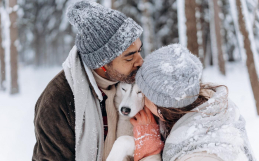Our deep connection with animals is evident from the first time we welcome a beautiful baby creature into our lives, to the tearful moment we are forced to say goodbye as they lay peacefully in our arms. Between those two events, the bond is clear through loving eye contact, displays of affection like belly rubs and head scratches, trust and empathy for each other, and vulnerability.
The Human Animal Bond is ubiquitous in our modern society. It’s present in the pure love we share with a furry companion at home, or the undeniable synergy between a person and their trusted animal worker, like a Border Collie methodically rounding up sheep.
These relationships aren’t specific to modern times. The earliest examples of bonds between humans and animals date back as far as 40,000 years ago with the domestication of dogs. Archaeological findings have demonstrated how early humans had relationships with dogs, as well as a variety of other animals like horses, goats, and cattle to aid in hunting, agriculture, and transportation.
Four-legged friends have always played an important role in people’s lives.
The topic is a passion for James Gillett, an associate professor at McMaster University in Hamilton, Ont. Gillett works in the school’s Department of Sociology, specializing in Health, Aging and Society. Gillett grew up on a farm in the foothills of Calgary, where animals were always present. Those experiences might explain why he developed a course at McMaster called “Kindred Species.”
“I have always been interested in capturing this idea of humans and animals having a kindredness, historically and currently,” Gillett says. “The course came from just always having animals in my life. As a sociologist, I was curious about understanding the dynamics underlying that relationship. That’s taken lots of different directions over the years.”
Gillett, who is “Dad” to a beloved six-year-old Jack Russell terrier named Cricket, researches both the changing relationships between humans and animals, and how the presence of animals can impact an environment and the people within it.
“To me, the bond is interesting in the ways that it unravels the categories that we create around humans and non-humans, how humans extend their humanness by having a relationship with an animal, and how being an animal changes when they have a relationship with a human,” he says. “Look at an Olympic equestrian horse, for example. The horse is an athlete and gets a medal, just like the rider. I find it interesting how the animal’s identity changes because of its relationship with a human.”
Gillett was involved in a program called Dogs at MAC, which placed therapy dogs in designated areas of the McMaster campus. A friendly German Shepherd named Liam (pictured) was partnered with a campus worker, the theory being that a therapy dog didn’t necessarily need to be involved in a therapeutic process, but was assessed as being well-behaved around people, so he was given an important role.
“We wanted to have a dog in the library, working with the librarian to provide emotional and social support to students, who were shy to ask the librarian for help or hesitant to engage with other people,” Gillett says. “Liam transformed both the librarian as a person, but also the space they were in. He was a calming presence to the students.
“An interesting aspect of this study was that libraries aspire to be what we call ‘third spaces.’ Libraries these days aren’t just places to take books out. They are really like another place, kind of like work but not work, and kind of like home but not home. So Liam, because of his association as part of this domestic sphere, helped to establish the library as a third space.
“He made people feel a little bit like they were at home, but also not at home. It’s how the Human Animal Bond expands outward into a social setting. It was an interesting instance of how you changed the identity of both the dog and the worker to create this new thing.”
Liam’s impact was lasting. When he sadly passed away, McMaster received a small grant from PetSmart to run a competition with the art school to create a portrait of Liam. The winning student’s portrait (same one pictured) now proudly hangs in the library, reminding everyone of the days this good boy spent helping the McMaster population feel more at ease and connected.
Liam’s work led to the university using a dog in the advising office in a similar way and another dog that was available for McMaster staff to have simple engagements with, like going for a walk. Gillett says the responses from staff suggested they felt more cared for by the university because of the dogs’ presence.
“I would make the argument that what has made the relationship between dogs and humans so long-standing and deep is that as two different species, we are both incredibly adaptive,” says Gillett. “They are socially evolving depending on the circumstances they are placed in, just as we are.
“That’s the fun part. We are kindred species constantly changing each other.”
This article is the second installment of an ongoing examination of the Human Animal Bond (HAB). Please visit James Gillett’s Instagram feed at https://www.instagram.com/kindredspecies
—————–






